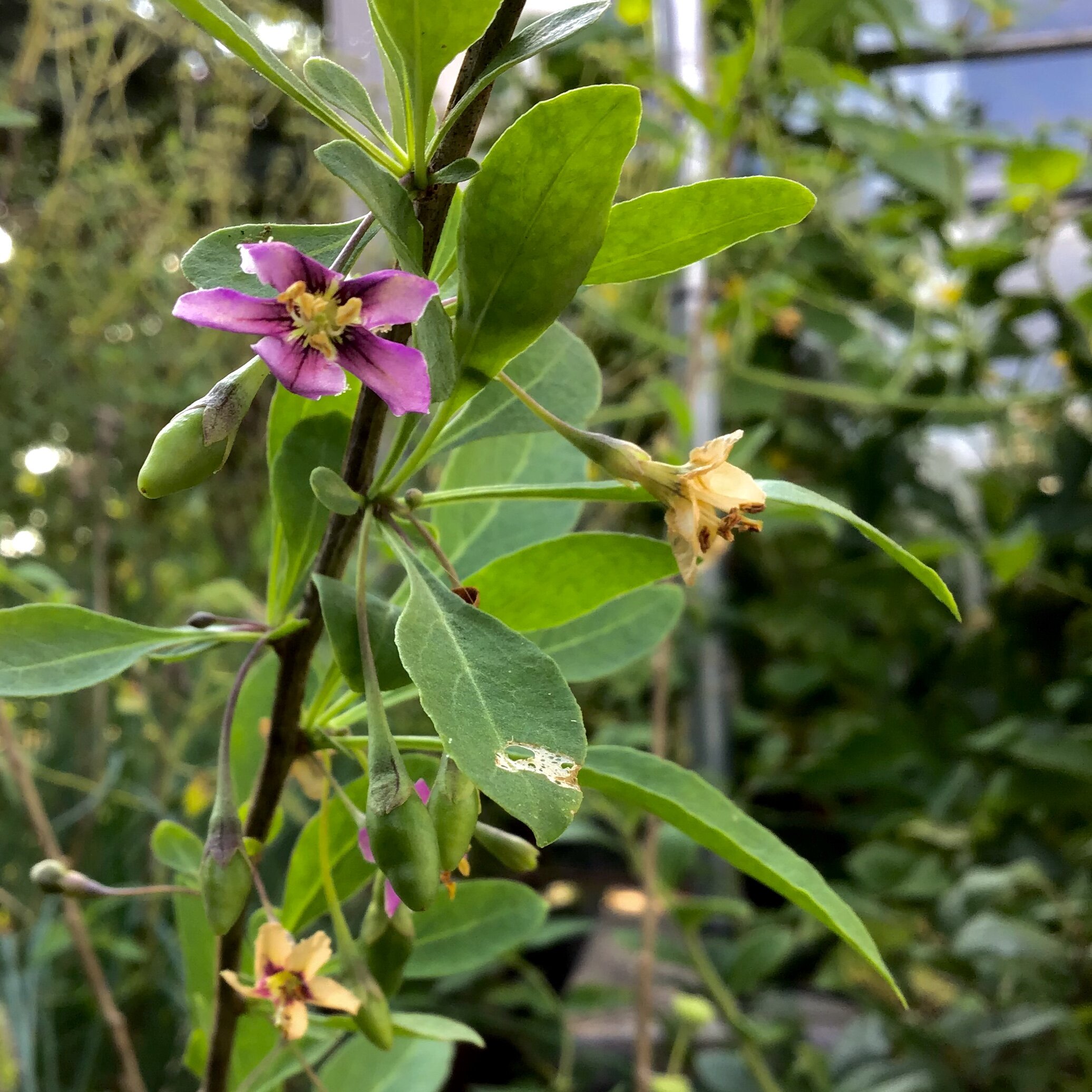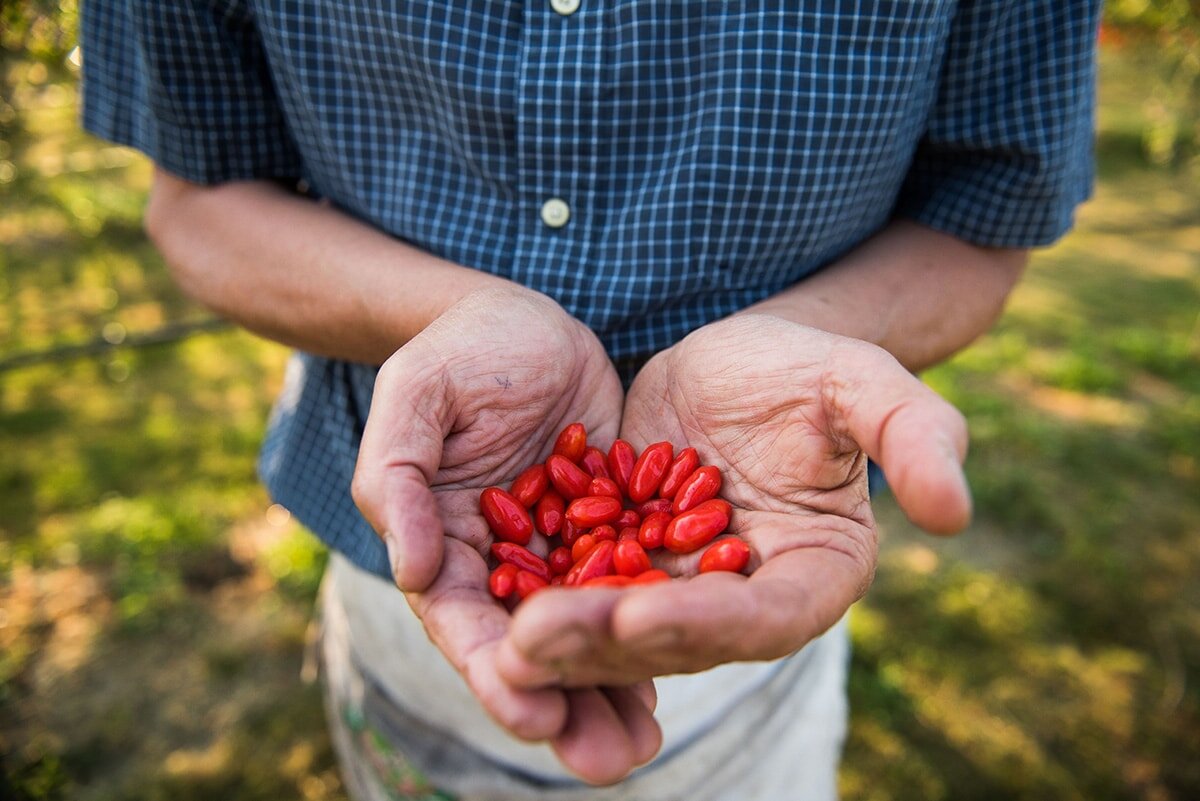Edible Eden’s resident Goji Berry plant is fruiting, and we thought it would be a fitting time to share some interesting facts about this edible plant!
The Goji Berry plant is a slightly thorny, deciduous woody shrub native to China. It can reach 12 feet tall but tends to droop (similarly to a weeping willow) and can easily be pruned for size. Goji Berry is a member of the Solanaceae family, also known as the nightshade family, which includes familiar plants like tomatoes, peppers, eggplants, and potatoes. Goji Berry is also known by several other names, including wolfberry, boxthorn, matrimony vine, or simply ‘Goji’.
The species of Goji that is most commonly used for fruit production is Lycium barbarum. However, there are a number of cultivated varieties that can be difficult to differentiate unless you buy a well-labeled plant from a reputable nursery. A related species, Lycium chinense, is said to produce rounder, sweeter berries, but is less commonly cultivated.
Edible Eden’s flowering and fruiting Goji Berry plant!
Growing Goji at home is fairly easy to do! Goji plants prefer fertile, loamy, well-drained soils with a neutral to very-slightly acidic pH. They are sensitive to high salinity in the soil and should not be planted near roadsides that may be salted during winter. However, Goji is very cold tolerant, surviving up to USDA zone 2. As long as your soil is not too heavy, wet, or salinified, Goji plants will grow vigorously; sometimes too vigorously! They will spread and may pop up in nearby areas of the garden, similar to raspberry brambles, and even have a similar cane-like structure.
Goji plants will begin to bear fruit relatively early, when the plant is only about 2 years old. If you are planting a nursery-grown transplant you will likely only have to wait until the following year for your first crop. Berry production will reach its maximum yield when the plant is about four to five years old.
The fruit-bearing flowers form along the entire length of the current year’s stems. Similar to raspberries, the stems (or canes) that fruited in the previous year should be cut back to the ground. The main purpose of pruning Goji plants is to remove spent canes that will block light and airflow to the rest of the plant. It is best to let the new canes reach their full length, then cut the very tip. This will increase your yield by encouraging lateral branches which will also produce fruit.
While you can prune for size if you are working with limited space, cutting back the current year’s new stems will reduce your yield. A better, more aesthetically pleasing way to use the space would be to train the canes over an arbor trellis. You may need a small ladder to harvest some of the fruit, but it keeps the area neat and really shows off the attractive red berries.
Now that you know how to grow Goji berries at home, maybe we should delve into just why you might want to do so! Goji berries are considered to be a “superfood” and have growing in popularity among health-conscious consumers. They can be particularly beneficial to vegan diets. The berries contain all 8 essential amino acids and are a surprisingly good protein source! There are about 4 grams of protein in every ounce of berries.
Goji berries are also rich in antioxidant compounds, and several preliminary studies have indicated that they can have positive effects on the aging process, energy levels, glucose control, immunomodulation, and more.
Unripe Goji Berries at Edible Eden’s HQ
Because of their medicinal value, it is always best to check with your doctor before adding Goji to your diet, especially if you are pregnant or have any pre-existing conditions. Goji berries can interact with certain medications or autoimmune issues, and may cause unwanted uterine contractions during pregnancy. The berries are considered to be safe and beneficial for healthy consumers.
Enjoying the berries fresh off the plant is an acquired taste; they can be pretty sour or bitter. They are most often dehydrated and enjoyed like dried cranberries, perfect to add to a salad or trail mix. We also found the following jam recipe on the Plant Based Eats Youtube channel.
Plant Based Eats Goji Berry Jam Recipe:
Ingredients:
1/2 cup of fresh goji berries. Or 1/4 cup of dried goji berries reconstituted in water for five minutes 1:1
7 medjool dates
2 tbsp of chia seeds
1 tsp of beet root powder
1 tbsp of lemon juice
1/2 cup of purified water
Instructions:
Blend for 20 seconds. Refrigerate for 30 minutes.
Refrigerate leftovers. Will stay good for a few days.
Makes 1 cup of jam.
*The lemon not only adds flavor and nutrition, it helps to naturally preserve the jam.




